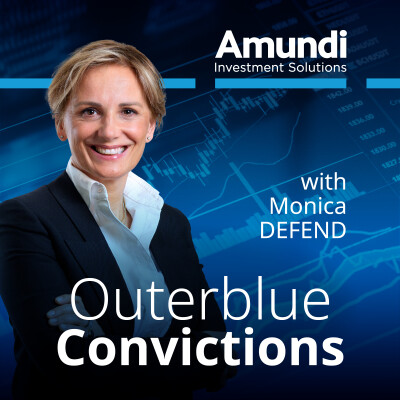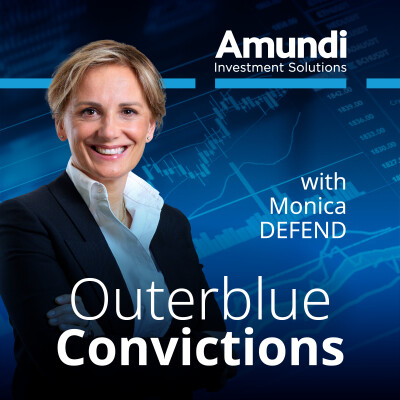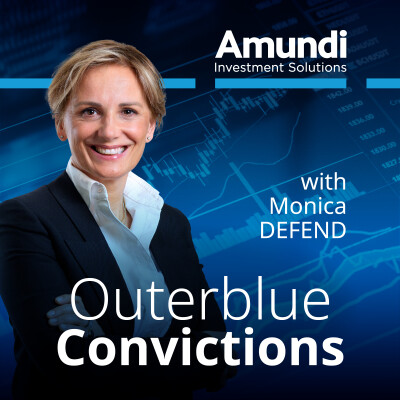- Disclaimer
This podcast is only for the attention of professional investors in the financial industry. Outerblue by Amundi. Welcome to Outerblue Convictions, Market Analysis and Asset Allocation Views.
- Swaha Pattanaik
Hello and welcome to this edition of our monthly Amundi podcast, where we discuss what lies ahead for economies and markets around the world, and also how that's affecting our thinking on asset allocation. I'm Swaha Pattanaik, the Head of Publishing, and it's my great pleasure to welcome Monica Defend, the Head of the Amundi Investment Institute. Hello, Monica.
- Monica Defend
Hello Swaha, and welcome back to everyone listening to us.
- Swaha Pattanaik
Monica, you were recently at the IMF World Bank annual meetings in Washington. There's so much going on in the world, but this meeting, which always attracts a large number of finance officials and bankers from around the world, is a really good place to take the pulse of what they're thinking and match it and compare it with what you and your teams are forecasting. What was the mood like on the ground in Washington, and how did the consensus views compare with what you and your team thinks lies ahead for us?
- Monica Defend
Yes, thank you. And actually this year to be sure I got all the information, the week following the IMF I've been invited to the Bund Summit in Shanghai. So I would say that really we've been travelling all around the world to gather as much information we can to pencil our outlook that will be released soon in November. So I would say in a nutshell that the prevailing tone is endurance rather than euphoria, with the consensus almost aligned on a constructive view on risk assets and this is due to growth that, albeit slowing down, is resilient and is resilient all over the place. I think when compared to our own forecast, on aggregate we don't see many differences. But as usual the devil is in detail and if I drill it down at country level, probably where we are less optimistic than the consensus and then the IMF, it's on the inflation pattern, where, for example, in the United States, for the 2026 forecast, we stay around 3%. So it looks like inflation, at least in the United States, is going to be structural. And I'm convinced this is due to the short-term uncertainty still related to tariffs and how this is reverberating to price dynamics. But we believe there are some structural trends related to this transformation that is in place into the economies, and probably the markets have been pricing it more in advance than what the current macro prints are showing. So inflation probably is going to be, still, one of the risks we will strictly monitor, closely monitor in the year to come.
- Swaha Pattanaik
Thank you, Monica. So let me pick up on something you were saying about markets picking up on the structural trends and regime sort of shifts in advance. But there's something interesting happening as well, we have seen equity markets hit the new record highs that you're talking about, but we've also seen the price of gold which used to be, or still is, the safe haven par excellence rally to an all-time high above four thousand dollars an ounce, before seeing a bit of a pullback. What do you think's going on because these are two odd things to coexist.
- Monica Defend
Well, on the equity side, I think the markets are really appreciating the accommodative stance of the central banks. So lower rates is something that usually our markets appreciate, equity markets appreciate, plus the earnings season is very good, so the tech rally continues. It is not really reverberating across all sectors and this will be key, something we are closely monitoring for the 2026 outlook. But this is what is in the price of the equity market. On gold, there is this long-term trend related to diversification out of US assets with respect to the US dollar to be less central. But what has been happening is that the central banks have been continuing to diversify their reserves out of Treasury and US dollar and this is set to continue. But what has been happening over the recent weeks is that also retail investors have been entering the trade because of the return and we expect this return to continue on the upside in the year to come due to the forces, the long-term trends, that are in place and we say we mentioned the central banks, but also demography, the decentralization of the US assets will continue to be in place. So thumbs up for gold price in the weeks and months to come.
- Swaha Pattanaik
Thank you Monica, okay good strong call there. You were talking about diversification earlier in the year we've sat down and discussed an interest that investors have had in Europe as a diversifier when they're looking for alternatives to this sort of very concentrated US rally which has been focused in a few companies, one or two sectors. How is Europe looking now?
- Monica Defend
Well, this is really something that struck me once back from the IMF meetings, because there are some ongoing changes taking place in Europe, along with this innovation-led transformation that refers to AI still. Maybe to a lesser extent than what we are seeing in Asia and in the United States, on the defense sector in particular, on the small cap sector in the European equities frame. Plus this search for strategic autonomy that is well present in Europe. Think about what is happening on the diversification that we are seeing on the energy supplies, the grid's plan that is meant to be delivered by the end of the year, plus some investments that are taking place on the private sector when it goes to automation, verticalization of AI in the industrial policies. So, I would say, as Mario Draghi recently said, that in Europe the train has left the station, it is now a matter of the train to be faster, to get speed. And this will come thanks to some kind of deregulation and a revision of the rules that we have on competition. So again, my takeaway from the IMF is really a more constructive view on Europe and as well as from Shanghai, I've seen a tangible interest of Asian investors into the European spectrum.
- Swaha Pattanaik
That's really interesting to hear. You mentioned Shanghai, you were there at a really appropriate time because it was just shortly after the release of the latest Chinese GDP data and you got a chance to get a feel of what it's really like with the economy and other sectors specifically that may have been of interest earlier this year. What are you expecting for the full year growth for this year and looking into next year for China?
- Monica Defend
Well, we've been revising up the GDP expectations thanks to the latest release. We think that they will be on track with the 5% target the authorities have. Just enough, I would frame it this way, the policy effort to support the economy to continue. They are trying to reduce the excess capacity, but they are running fast as far as technology in the broad sense is concerned. So again, probably the train is running faster than in Europe, but definitely the direction of travel is quite clear.
- Swaha Pattanaik
Thanks, Monica. So let's stay in Asia. And for my final question, perhaps I could ask you about the new Japanese prime minister, the first female Japanese prime minister they've ever elected and how you think her priorities and plans might affect Japanese assets. We're already seeing the impact very early on.
- Monica Defend
Yes, indeed. They will try to support the consumer side due to the elevated level of prices, of inflation, through subsidies, tax cuts. What is interesting, I think, in Japan is the interaction between the monetary policy and the government view. We just had the BOH that kept its policy rate unchanged at 0.5 in its October meeting and in the context of these recent political changes, this decision from the central bank has kind of reignited the debasement trade that is reflected primarily in renewed weakness on the currency side and we think this will last. It will take time we think, before the central bank will start normalising its policy rate and we keep the idea that the door is open for a hike. It might be in December or early next year.
- Swaha Pattanaik
Thank you Monica. Well we're unfortunately out of time. It always goes so quickly. But we really appreciate you covering so much ground, Monica, in such a short space of time. It's not even ground on the actual sort of ground on the ground, with the air miles covered as well.
- Monica Defend
Indeed, thank you, Swaha.
- Swaha Pattanaik
And both of us would like to thank you for tuning in. As Monica mentioned, we are currently finishing up our outlook for 2026. And next month, we will be back with Monica to take a longer look at the year ahead and what we can expect, the views from her and her team. In the meantime, check out our Research Center for more on our latest thinking.
- Disclaimer
This podcast is only for the attention of professional investors as defined in Directive 2014-65-EU, dated 15 May 2014, as amended from time to time on markets and financial instruments called MIFID II. Views are those of the author and not necessarily Amundi Asset Management's SAS. They are subject to change and should not be relied upon as investment advice, as a security recommendation, or as an indication of trading for any Amundi products or any other security, fund units, or services. Past performance is not a guarantee or indicative of future results.





